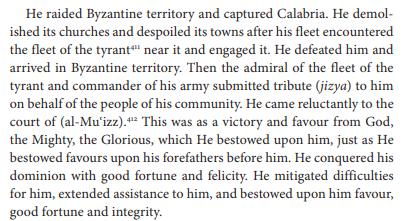A 10th-century Description
This snippet is from the history of Qadi l-Nu’man, one of the main da’is of the Fatimid state.


Source, pp. 234-5.
An 11th-century Description
This snippet is from a Persian travelogue written by a Shi’i traveler from Khorasan (modern Tajikistan) who went on pilgrimage to Mecca via Fatimid Cairo in the 11th century. In this passage, he is describing the army.
There is also a contingent of princes from all over the world–the Maghreb, the Yemen, Byzantium, Slavia, Nubia, and Abyssinia–who have come here but who are not reckoned in the ranks of the regular army. The sons of the Chosroes of Daylam and their mother have also come here, and the sons of the Georgian kings, Daylamite princes, the sons of the khaqan of Turkistan, and people of other ranks and stations, such as scholars, literati, poets, and jurisprudents, all of whom have fixed stipends. No aristocrat receives less than five hundred dinars. The only function they have to perform is to make a salaam to the grand vizier when he mounts his horse, and after that they can withdraw to their places.
Source, 63-4.